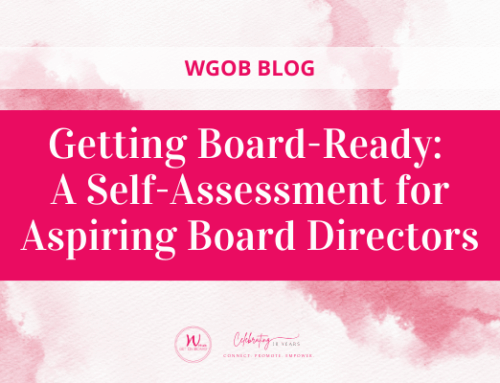Women Get On Board Inc. (WGOB) is a member-based company that connects, promotes and empowers women to corporate boards.
On November 17, WGOB hosted a virtual event sponsored by our National Strategic Partner Gowling WLG. Leading experts offered advice on successfully addressing shareholder activism as an independent director in a panel discussion format.
Deborah Rosati, FCPA, FCA, ICD.D, Corporate Director, Founder & CEO of WGOB, kicked off the panel by introducing the moderator, Gregory Peterson. Gregory is a senior partner at Gowling WLG, where he leads the firm’s Corporate Finance, M&A and Private Equity Group in the firm’s Calgary office. To begin the conversation, Gregory introduced the members of the panel, who both possess extensive experience navigating the realm of shareholder activism:
- Alyssa Barry, Principal & Co-Founder of irlabs
- Jacob Cawker, Partner at Gowling WLG
The panellists opened the webinar by discussing the indicators that may suggest to a firm that shareholder activism is on the horizon. If directors know what to look for, they can better prepare for it.
“Shareholder activism should never be a surprise,” said Alyssa.
She explained that activist events typically emerge as the result of persistent underperformance by a company. Shareholder activism is also likely to occur when a firm makes a contentious transaction or an announcement that creates waves in the markets.
Although business strategy is typically a top issue for activists, investors are also becoming more focused on targeting governance and ESG matters. Accordingly, boards should be prepared to engage with investors on any timely topics as they arise.
How should directors prepare for and respond to shareholder activism?
All directors have a duty to act in the best interest of the corporation they serve. But what does that mean in the context of addressing shareholder activism?
Preparation should start with the organization’s governance.
“Having a rock-solid governance framework is critical,” said Alyssa.
Directors should proactively address gaps in the board’s governance, recognizing that activists will search for loopholes in the governance framework.
Beyond governance, the most effective method to prepare for or deter shareholder activism is to practice strong shareholder engagement. Be proactive. Know who your investors are, who is most engaged and who requires the most attention. Spend time with those investors to understand their needs and ideas. Showing that the board’s door is always open is essential.
When activists do come knocking, directors should promptly assemble a team of qualified advisors and establish an independent committee to manage the situation. In addition to getting the necessary processes in place, directors should focus on staying professional. Alyssa explained that directors should be prepared to remove their personal feelings from the situation in any shareholder activism event. When emotion gets the best of any of the parties involved, those actors often do not make the strongest decisions for the company.
“Whenever I’ve seen something go wrong in our engagement, it’s been due to emotion,” said Alyssa.
What is the role of independent directors?
Independent directors are uniquely positioned to support the process of addressing shareholder activism. Because they are free from material relationships with the company, they have no competing interests that could cause problems in shareholder activism scenarios.
“Independent directors have an inherent advantage in being better positioned to evaluate the claims and arguments,” said Jacob.
Independent directors are also less likely to be criticized by an activist. For this reason, independent directors should play a prominent role in shareholder activism scenarios, and in many cases, they should be assigned as the main contact for the activists.
What should you do if an activist approaches you to participate in a dissident slate?
It’s undoubtedly flattering to be asked to join an activist slate as an independent director. However, it is vital to evaluate the risks prior to participating.
Before agreeing to involvement, research the potential activists and their track record of activism. Determine if they have a history of quiet activism that is resolved quickly, rather than more disruptive, public action.
Potential nominees should also consider the activist’s central thesis or cause for concern within the company. Directors should discern if they agree with the activist’s position and whether the actions would be in the company’s best interests. After all, unlike shareholders, directors must adhere to their fiduciary duty to do what is best for the company.
What is the activist’s perspective?
As directors work to address shareholder activism, it can be helpful to understand the perspective of activists. Alyssa provided an overview of the process an activist might take to identify nominees for their slates. She explained that activists commonly spend months or even years preparing for their moment.
“The activist is typically way ahead of the issuer,” said Alyssa.
Activists begin by socializing the opportunity to potential participants and conducting a conflict check to ensure the candidates do not have any relationships with management that could pose problems. This step is also a chance to obtain the nominee’s perspective on the thesis of the action. By the end of the exercise, the potential nominee will be able to determine if the movement interests them.
Generally, activists will provide multiple nominee options to companies in a gesture of good faith. In general, all parties want to ensure the nominees add value to the board and the organization.
What steps can independent directors take to protect themselves when joining a board?
Jacob explained that it is critical for directors to protect themselves from the risks posed by proxy contests from the moment they join any board. First and foremost, every director should arrange a protective indemnity agreement between themselves and the company from day one. In fact, it should be a condition for anyone agreeing to serve on a board of directors, in Jacob’s opinion.
Directors should also confirm the adequacy of the available officer and director liability insurance. It’s common for proxy contests to involve some form of litigation, which increases the risk profile for directors. Fulsome insurance provides peace of mind so that directors can make the best decisions for the company without worrying about personal risk.
In addition to addressing the legal issues, directors can also manage risks by maintaining open lines of communication with other independent directors. Ideally, independent directors should include regular conversations on pertinent matters in every meeting schedule.
“A strong connection between all independent directors will ensure that their voice, as the independent board, remains strong in the boardroom,” said Jacob.
That voice will be critical if a shareholder activism event arises in the future.
It is vital that directors understand shareholder activism issues and prepare adequately for such events. No matter their role, every director should ensure they know how to respond to shareholder activism when it occurs.
Are you interested in learning more about effective boards and governance? Join us for our next WGOB Speaker Series on November 30th for “Purpose Led Companies – the Role of the Board?” sponsored by MNP LLP. Register here.






